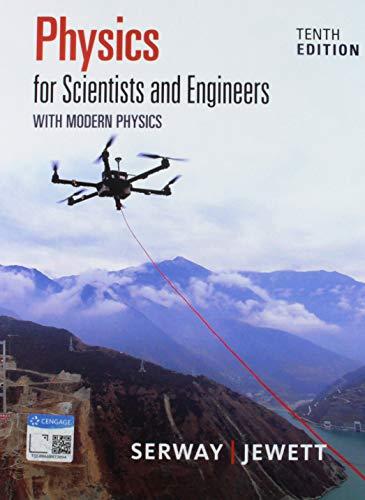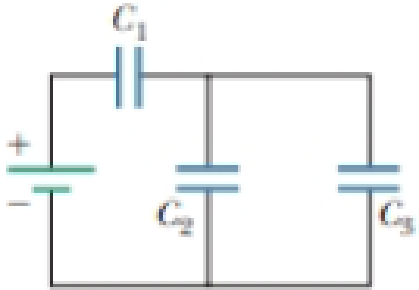
Concept explainers
Three capacitors are connected to a battery as shown in Figure P25.10. Their capacitances are C1 = 3C, C2 = C, and C3 = 5C. (a) What is the equivalent capacitance of this set of capacitors? (b) State the ranking of the capacitors according to the charge they store from largest to smallest. (c) Rank the capacitors according to the potential differences across them from largest to smallest. (d) What If? Assume C3 is increased. Explain what happens to the charge stored by each capacitor.
Figure P25.10

(a)
The equivalent capacitance of this set of capacitors.
Answer to Problem 10P
The equivalent capacitance of this set of capacitors is .
Explanation of Solution
Given information: The value of capacitor 1 is
The capacitors
Formula to calculate the equivalent capacitance of the system when they are connected in parallel.
Here,
Substitute
Thus, the equivalent capacitance of the system when they are connected in parallel is
The capacitors
Formula to calculate the equivalent capacitance of the system when they are connected in series.
Here,
Substitute
Thus, the equivalent capacitance of this set of capacitors is
Conclusion:
Therefore, the equivalent capacitance of this set of capacitors is
(b)
The ranking of the capacitors according to the charge they store from largest to smallest.
Answer to Problem 10P
The ranking of the capacitors according to the charge they store from largest to smallest is
Explanation of Solution
Given information: The value of capacitor 1 is
Calculate the voltage across
Here,
Substitute
Calculate the charge for the capacitor
Here,
Substitute
Thus, the charge for the capacitor
Calculate the charge for the capacitor
Here,
Substitute
Thus, the charge for the capacitor
Calculate the voltage across
Here,
Substitute
Calculate the charge for the capacitor
Here,
Substitute
Thus, the charge for the capacitor
The ranking of the capacitors according to the charge they store from largest to smallest is
Thus, the ranking of the capacitors according to the charge they store from largest to smallest is
Conclusion:
Therefore, the ranking of the capacitors according to the charge they store from largest to smallest is
(c)
The ranking of the capacitors according to the potential differences across them from largest to smallest.
Answer to Problem 10P
The ranking of the capacitors according to the potential differences across them from largest to smallest is
Explanation of Solution
Given information: The value of capacitor 1 is
Calculate the potential difference across
Here,
Substitute
Thus, the potential difference across
Calculate the potential difference across
Here,
Substitute
Thus, the potential difference across
Calculate the potential difference across
Here,
Substitute
Thus, the potential difference across
The ranking of the capacitors according to the potential differences across them from largest to smallest is
Thus, the ranking of the capacitors according to the potential differences across them from largest to smallest is
Conclusion:
Therefore, the ranking of the capacitors according to the potential differences across them from largest to smallest is
(d)
The effect acting on the charge stored by each capacitor if
Answer to Problem 10P
The effect acting on the charge stored by each capacitor if
Explanation of Solution
Given information: The value of capacitor 1 is
If the value of capacitor 3 is increased, the total capacitance will increase which results in increasing the total charge.
Due to this, the charge across capacitor 1 increases.
Since, the charge across capacitor 1 is directly proportional to the voltage across the capacitor 1. So, the voltage across
Since the voltage across the capacitor 2 decreases, charge across the capacitor 2 also decreases and the voltage across the capacitor 3 decreases, charge across the capacitor 3 also decreases.
Thus, if
Conclusion:
Therefore, if
Want to see more full solutions like this?
Chapter 25 Solutions
Bundle: Physics For Scientists And Engineers With Modern Physics, 10th + Webassign Printed Access Card For Serway/jewett's Physics For Scientists And Engineers, 10th, Multi-term
Additional Science Textbook Solutions
SEELEY'S ANATOMY+PHYSIOLOGY
Fundamentals Of Thermodynamics
Microbiology Fundamentals: A Clinical Approach
Applications and Investigations in Earth Science (9th Edition)
Anatomy & Physiology (6th Edition)
- The figure gives the acceleration a versus time t for a particle moving along an x axis. The a-axis scale is set by as = 12.0 m/s². At t = -2.0 s, the particle's velocity is 11.0 m/s. What is its velocity at t = 6.0 s? a (m/s²) as -2 0 2 t(s) 4arrow_forwardTwo solid cylindrical rods AB and BC are welded together at B and loaded as shown. Knowing that the average normal stress must not exceed 150 MPa in either rod, determine the smallest allowable values of the diameters d₁ and d2. Take P= 85 kN. P 125 kN B 125 kN C 0.9 m 1.2 m The smallest allowable value of the diameter d₁ is The smallest allowable value of the diameter d₂ is mm. mm.arrow_forwardWestros, from Game of Thrones, has an area of approximately 6.73⋅106 miles26.73⋅106miles2. Convert the area of Westros to km2 where 1.00 mile = 1.609 km.arrow_forward
- a) What is the lenght of x? b) Findθ c) Find ϕarrow_forwardA surveyor measures the distance across a straight river by the following method: Starting directly across from a tree on the opposite bank, he walks x = 97.7 m along the riverbank to establish a baseline. Then he sights across to the tree. The angle from his baseline to the tree is θ = 33.0 °. How wide is the river?arrow_forwardA small turtle moves at a speed of 697. furlong/fortnight. Find the speed of the turtle in centimeters per second. Note that 1.00 furlong = 220. yards, 1.00 yard = 3.00 feet, 1.00 foot = 12.0 inches, 1.00 inch = 2.54 cm, and 1.00 fortnight = 14.0 days.arrow_forward
- The landmass of Sokovia lifted in the air in Avengers: Age of Ultron had a volume of about 1.98 km3. What volume is that in m3?arrow_forwardA fathom is a unit of length, usually reserved for measuring the depth of water. A fathom is exactly 6.00 ft in length. Take the distance from Earth to the Moon to be 252,000 miles, and use the given approximation to find the distance in fathoms. 1 mile = 5280 ft. (Answer in sig fig.)arrow_forwardNo chatgpt pls will upvotearrow_forward
- One of the earliest video games to have a plot, Zork, measured distances in “Bloits” where 1 Bloit was defined as the distance the king’s favorite pet could run in one hour, 1,090 m. In the same game the king has a statue made that is 9.00 Bloits high. What is this in meters?arrow_forwardNo chatgpt pls will upvotearrow_forwardNo chatgpt pls will upvotearrow_forward
 Physics for Scientists and Engineers: Foundations...PhysicsISBN:9781133939146Author:Katz, Debora M.Publisher:Cengage Learning
Physics for Scientists and Engineers: Foundations...PhysicsISBN:9781133939146Author:Katz, Debora M.Publisher:Cengage Learning Physics for Scientists and Engineers with Modern ...PhysicsISBN:9781337553292Author:Raymond A. Serway, John W. JewettPublisher:Cengage Learning
Physics for Scientists and Engineers with Modern ...PhysicsISBN:9781337553292Author:Raymond A. Serway, John W. JewettPublisher:Cengage Learning Physics for Scientists and EngineersPhysicsISBN:9781337553278Author:Raymond A. Serway, John W. JewettPublisher:Cengage Learning
Physics for Scientists and EngineersPhysicsISBN:9781337553278Author:Raymond A. Serway, John W. JewettPublisher:Cengage Learning Principles of Physics: A Calculus-Based TextPhysicsISBN:9781133104261Author:Raymond A. Serway, John W. JewettPublisher:Cengage Learning
Principles of Physics: A Calculus-Based TextPhysicsISBN:9781133104261Author:Raymond A. Serway, John W. JewettPublisher:Cengage Learning Physics for Scientists and Engineers, Technology ...PhysicsISBN:9781305116399Author:Raymond A. Serway, John W. JewettPublisher:Cengage Learning
Physics for Scientists and Engineers, Technology ...PhysicsISBN:9781305116399Author:Raymond A. Serway, John W. JewettPublisher:Cengage Learning





